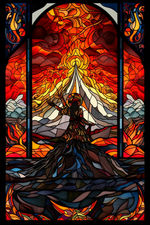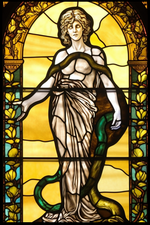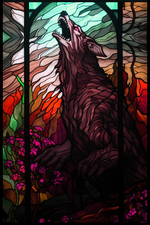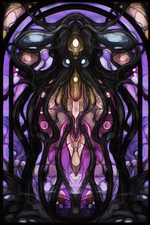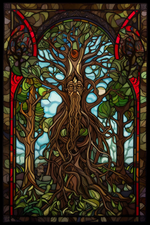|
Etna's Fire was a monotheistic Ailor Pagan Religion that started in the modern day area of Montania, more specifically Terre di Fuoco, when the Vularos people still lived there. The Vularos people were a pre-civilization decentralized collection of tribes who despite their lack of organized state structure, were capable of erecting impressive pumice hill forts and townships which frequently fought over the scarce resource of the Montania rugged mountainous landscape. The Vularos people were either enslaved, expelled, or incorporated into the incoming Ithanian and Daendroque settlers who claimed the land as an expansions for the rapidly growing Regalian Empire. Etna's Fire is no longer worshiped in the modern era, as the Vularos are essentially extinct, but Etna's symbolism is still important for Vultaro & Montania, and by extension the Dressolini people, because they still live at the feet of these imposing volcanoes.
Etna's Fire in particular described the fear-worship of Etna, the largest massive volcano in Terr di Fuoco, the king of all volcanoes. The Vularos believed that each Volcano was a finger from the hand of Etna, a god-like being that lived underground and tried to reach the surface from which it had been expelled. Etna is traditionally depicted as a non-gendered individual with volcanic rock for skin, marred by cracks of lava, and three arms of the past, present, and future. Etna worship involved bringing sacrifices of animals and fruit to slumbering volcanoes, and sometimes even the sacrifice of maidens to the flame if a volcano erupted in the hopes it would soothe Etna's burning rage with a distraction of a kind. The Vularos knew that other regions in the Archipelago had no volcanoes, but chose not to move anyway, believing in the folklore that their people were descendent from the Vult, powerful wizards who had expelled Etna underground, and thus were responsible for ensuring Etna's docile passivity in all perpetuity.
Unionism and waves of Ithanian and Daen immigrants effectively eradicated Etna's Fire as a religion, the Volcano that still bears Etna's name bears some artistic importance, but very little is left of the Vularos people as earthquakes and eruptions destroyed most of the centuries old ruins in the remote areas of the Montania region.
|
The Gilded Order
|
The Gilded Order is a monotheistic Ailor Pagan Religion that started on the Regalian Isle, and was predominantly worshiped by the citizens of the Regalian Kingdom, insofar they were not Old Gods or Dragon Worshipers. The Gilded Order is still a very small minority Religion that survived centuries of Unionist conversion, so it may still be possible to encounter some Gilded Order faithful, but only on the Regalian Isle because the religion is dead everywhere else. The Gilded Order unlike most other Pagan Faiths is not strictly tied to any particular Ailor tribe, rather it is a religion that came about from the general sense of superiority and divine exceptionalism of the inhabitants of the Regalian Isle, because they considered themselves divinely ordained to be the center of the world (at least seen from the Archipelago).
The Gilded Order has a single female Goddess called Shianna or Shianna's Grace. This religion has no strict virtues, priesthood, or vices, rather it is a general fertility and pleasure cult that ascribes divine fate and purpose to those living on the Regalian Isle, and proposes the exceptionalism of those born there, versus the "Outlanders" (people who were born off the Regalian Isle). The Gilded Order is not strictly bigoted against outsiders, but insist that only those born in the light of Shianna's Grace on the Regalian Isle can receive her blessings and benediction. She is a Goddess of motherhood, the divine and carnal pleasures of life, the fruits of good harvests, and the plentiful splendor and sparkle of the natural resources in the ground.
The Gilded Order was made illegal in the Empire sometime after the first century because the religion started behaving more like a syncretic pleasure cult among the Crypto-Unionists (Pagans who pretended to convert to Unionism but secretly worshiped their old religion at home). Shianna's masks became symbolic for the religion, showing a woman's face crying tears of gold, with a golden halo surrounding the mask so as to appear like a radiant sun. This religion hid underground, hosting a variety of opulent and decadent parties as if the Empire had never replaced the Regalian Kingdom, where the Gilded Order was a state religion. To this day, it is suspected less than 50,000 faithful remain on the Regalian Isle of a population of 4 million, though it skews more favorably to the wealthy, who see dabbling into the Gilded Order as more of a hobby than a genuine spiritual interest.
|
The Blood Covenant
|
The Blood Covenant is still a very much living and breathing religion that originated from Old Ceardia, but has since spread almost globally, at least wherever Velheim settlers have gone. The Blood Covenant is seen as part ancestor, influencing, but also being influenced by Old Gods, as it predates Old Gods as a religion, and may well be one of the oldest Ailor religions still around. The Blood Covenant is by some Old Gods faithful considered a heresy, because it denounces Arne, and the other Old Gods, favoring a very much fixated focus on Halfvel and the Godcursed Marken. The Blood Covenant is still existing in various parts of the world, but is particularly popular in Talahm Gall, the more clan and tribal lands of Gallovia where the Gallovian Ailor live, and few Regalian missionaries dare go for the tales of Marken who defend their Queen of Blood.
The Blood Covenant worships a monotheistic female Marken goddess called the Queen of Blood, or the Matron of the Covenant. The Blood Covenant was once a very different religion thousands of years ago, but an event called the Bloodrot which coincides with the betrayal of Jord and Gro in Old Gods, swiveled the Blood Covenant from a fairly peaceful wolf-worshiping religion, into a rather violent cult of Marken with a vengeance. It is said that Halfvel, the only Old God recognized from the Old Gods pantheon, is the consort of the Queen of Blood, herself a massive wolf goddess, and that the Marken are her children. She however is barren, and so killed an Old God, from which the rotting corpse oozes so-called Rotten Blood, which if consumed causes a person to become Marken. This phenomena is somewhat studied because it happens somewhat close to Regalia, with scholars verifying that the Blood is not quite Occult in origins, but causes manifestations of Primal Revenants in those who consume it, that turn them onto a dark path of violence.
The central command of the Blood Covenant is to consume the Rotten Blood, as to fight the "encroachment of all that is golden", but also to avenge the event called the Bloodrot (though it remains somewhat unclear what this means, it just instills a dislike of Old Gods worshipers). The encroachment of all that is golden appears more like an analogy against the march of progress, in essence: fighting against anti-Magic sentiments, fighting against colonization, fighting against the eradication of tribal or uncivilized societies by centralized states, fighting for the autonomy of culturally dissonant regions, and having an intense hatred for lies, deceit, and falsehoods. Worship of the Blood Covenant is done by sacrificing animals (and sometimes, people), and consuming their heart before going on the hunt, with the hunt being either literal, or figurative for an enemy.
|
The Midnight
|
The Midnight is an extinct religion that nonetheless is very well recorded religion that originated with the Sarnt tribes, natives of Drixagh before the Velheim colonists exterminated these tribes and dominated the area. The Sarnt people were not too dissimilar from the Velheim in the modern era, but were a series of tribes that long existed in the Drixagh region before the first waves of Velheim settlers arrived through the Vaarda Gates. The Sarnt waged a series of brutal wars with the Velheim who they considered hostile invaders (it remains somewhat nebulous whether they were), and were essentially extinct through a combination of defensive wars and Velheim enslavement which reduced their population growth to a crawl, or outright integrated them into the Velheim population. The Sarnt are however well studied, because they were a semi-cave dwelling people who left behind a lot of archeological evidence of their existence, including wall-murals of the Midnight.
The Midnight is both the name of the religion, as well as the entity that they fear-worshiped, an incomprehensible cosmic being that represented the darkness, fear, and dangers of the night. The Midnight was believed to be a black inky and non-solid entity that gained power as the light faded from the world during nighttime, reaching the height of its power during midnight, at which point it would terrorize the people and seek to consume their souls. The Sarnt during the day lived in villages or towns hewn from rock, while at night, they would retreat into the caves at night to spend the night there behind a magically sealed door. Many of these magically sealed doors remain, many of them even unopened to this day because of the strength of Magic used by the Sarnt. Why the Sarnt supposedly hunted to consume souls, and whether it was even a real entity remains unclear, though many of the legends and folklore could be gleamed from the cave murals, as the Sarnt language was fairly easy to translate, and they were literate.
There has been some scholarly debate as of late whether the Midnight might actually have been Inthalis, a god of Void Worship, because there are some visual similarities between the way the Sarnt depicted them on their murals, versus the way Inthalis's conduit has appeared in Regalia of late. This also has raised the question, why Inthalis would show such particular interest in a pre-civilization Ailor tribe, in a time when the Allorn Empire presumably commanded far more knowledge, than such a brutish people could. The question is raised, what did the Sarnt know that made them such a target?
|
Sarna
|
Sarna is the name of both the religion and the god of the Sarnan people, not to be confused with the Sarnt who were nonetheless hundreds of miles apart from one another, but vaguely related due to both being pre-civilization Regalian Archipelago tribes. The Sarnan were an all-ginger-haired tribe of Ailor who lived in modern day Osteiermark and Tirgunn regions. The Sarnan people largely avoided the spotlight of the Regalian Empire, because the Regalian Empire at the time was focusing their efforts on the much larger Wirtemcaller people living north of the Sarnan, and colonizing the mineral rich soil of the Vularos people. Eventually, Ithanian and Wirtem expansion encroached on the Sarnan people, who were segregated into slum villages, and eventually disappeared in the Leutz-Vixe gene-pool, thus explaining why many Leutz-Vixe are ginger. Sarna as a religion is effectively extinct, but some of it is still contextually relevant to the Artifact Coraveau, and the various Raven-lord Cults that existed in Tirgunn and Osteiermark.
Sarna, otherwise also called the Tree Father or the Pinewald Father, was a benevolent tree-god who supposedly lived somewhere in the Tirgunn forests, a massive tree with the face of an old man that protected the Sarnan people from the beasts that lived in these forests. Many of these beasts are no longer around nowadays, as the Leutz-Vixe hunted them all to extinction with modern Regalian armor and weapons, though they posed a considerable threat to the Sarnan people who lived in mud brick and thatch housing and had not yet discovered metal working. The Sarnan suffered severely from Vampiric raids, which eventually meant that Sarna as a religion became very focused around fighting the ruinous powers of the Void, and the corruption of Void-Occult entities. In many ways, Sarna is a purist religion against the Occult, with many of the Sarnan wielding their albeit crude tools and weapons, to become very efficient Occult-hunters. The very act of slaying a Vampire and blood-letting their corrupted blood into a cleansing fire, was considered a very pious act.
Sarna as a religion was still somewhat held onto by the various Sarnan who merged into the Leutz-Vixe population, meaning there are still some shrines that were erected relatively recently in the last 100 years found across the provinces where they once lived, but no active shrine has been seen in the last 50 years at least, meaning the Regalian Scholar Society has concluded that the religion is most likely extinct. (Though, you are permitted to play a Crypto-Unionist who externally pretends to be a Unionist, but is secretly a Sarna worshiper in private (tracing clear lineage to Sarnan marrying into Leutz-Vixe families), though only if they are ginger, Leutz-Vixe in culture, and a Darkwald Lothar Knight).
|
Trivia
- Pagan within the canon universe refers to religions pre-dating Unionism. While this technically also includes Old Gods from the perspective of the Ailor, because Old Gods is such a large and populous religion in the modern era, it is not included in classical categorization, even if some Old Gods worshipers refer to themselves as "The Pagan".
- Not all Pagan religions were Monotheistic, but in general the majority of them are, and at least all the Pagan religions that are well known or to some degree understood and still around. Why Ailor religions suddenly swapped from Monotheistic to Polytheistic is unknown, though it is speculated to have been related to a widening of perspective on the world from only regional awareness, to global awareness.
- It is not permitted to play a person of a religion that is dead. Religions that are not dead are clearly indicated. Religions that are hidden (pretending to be dead) are also clearly defined, with expectations for secret requirements.
Template:Religions
|
|
|
|
|
